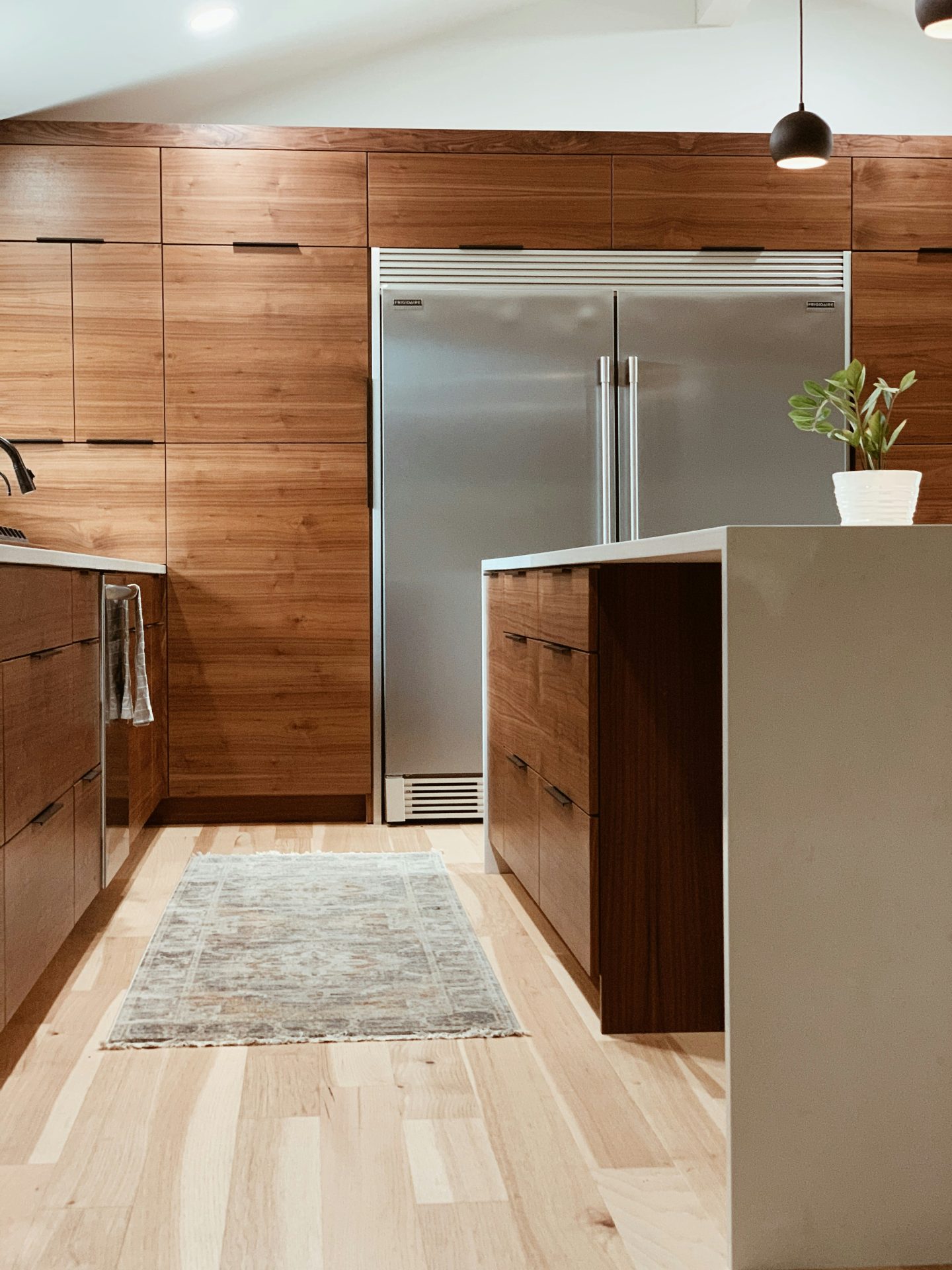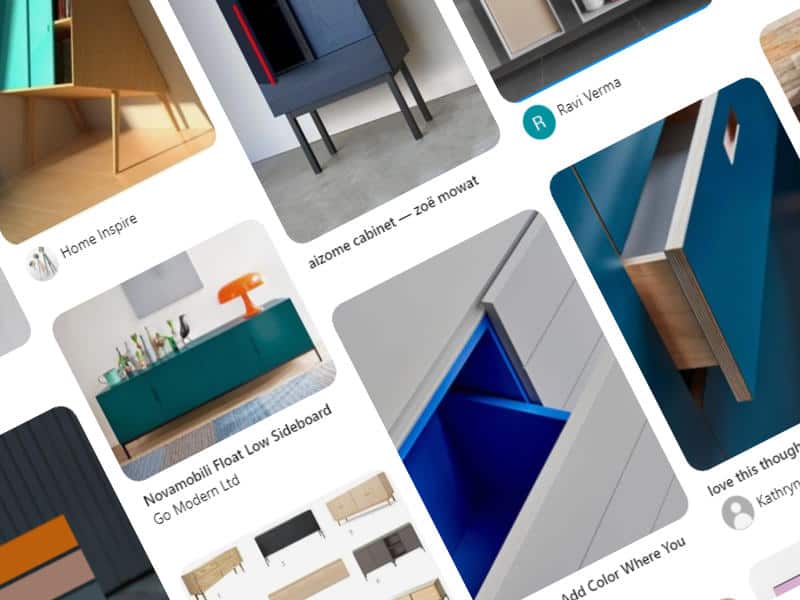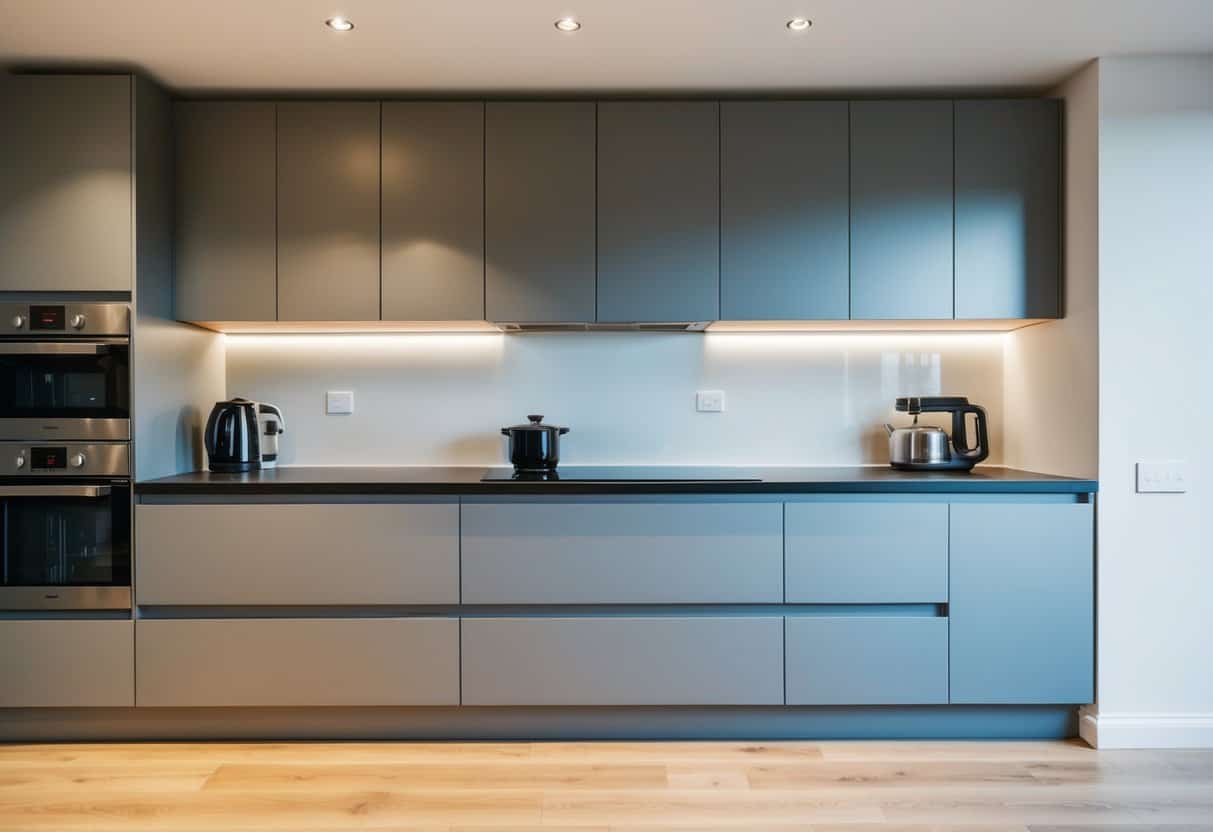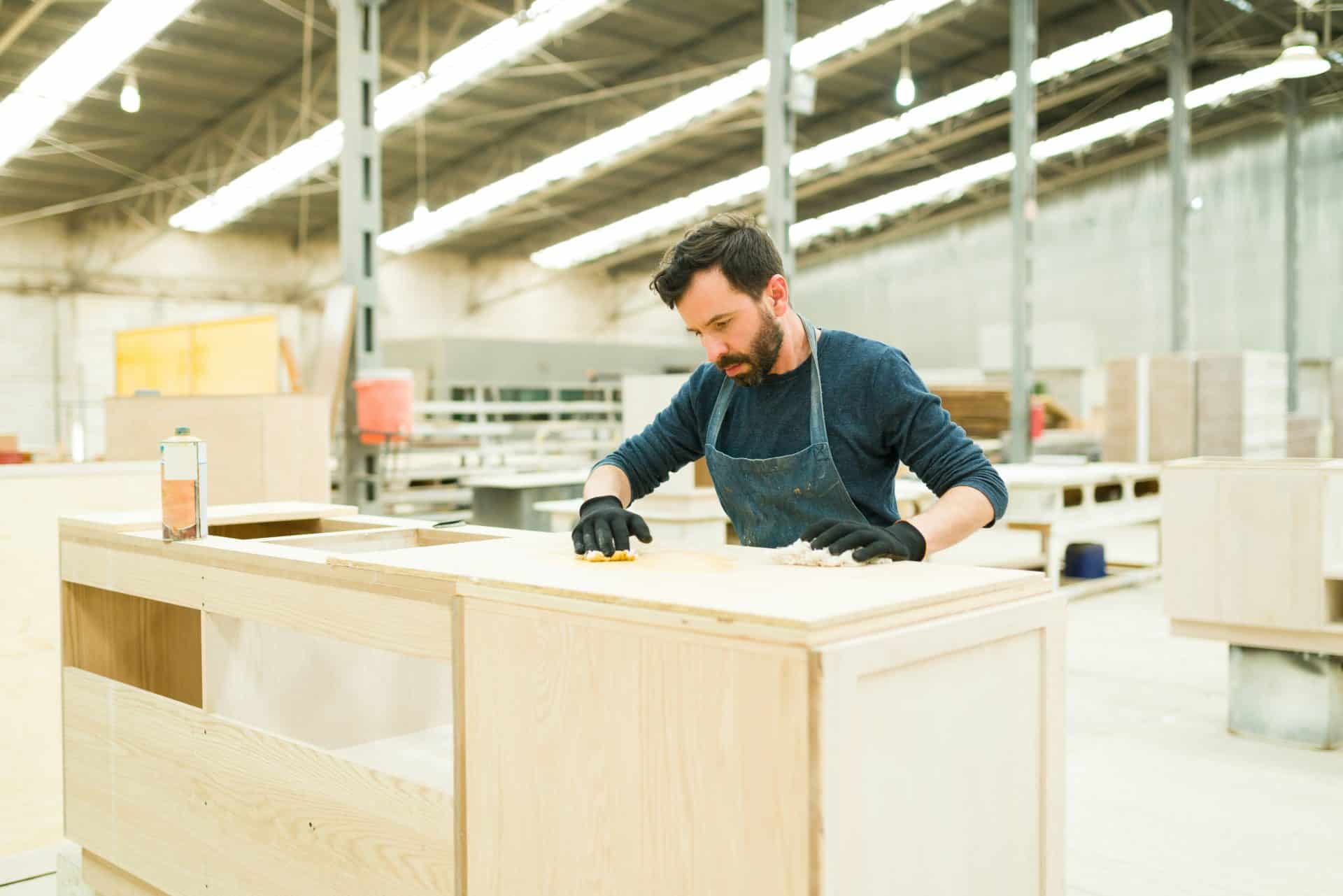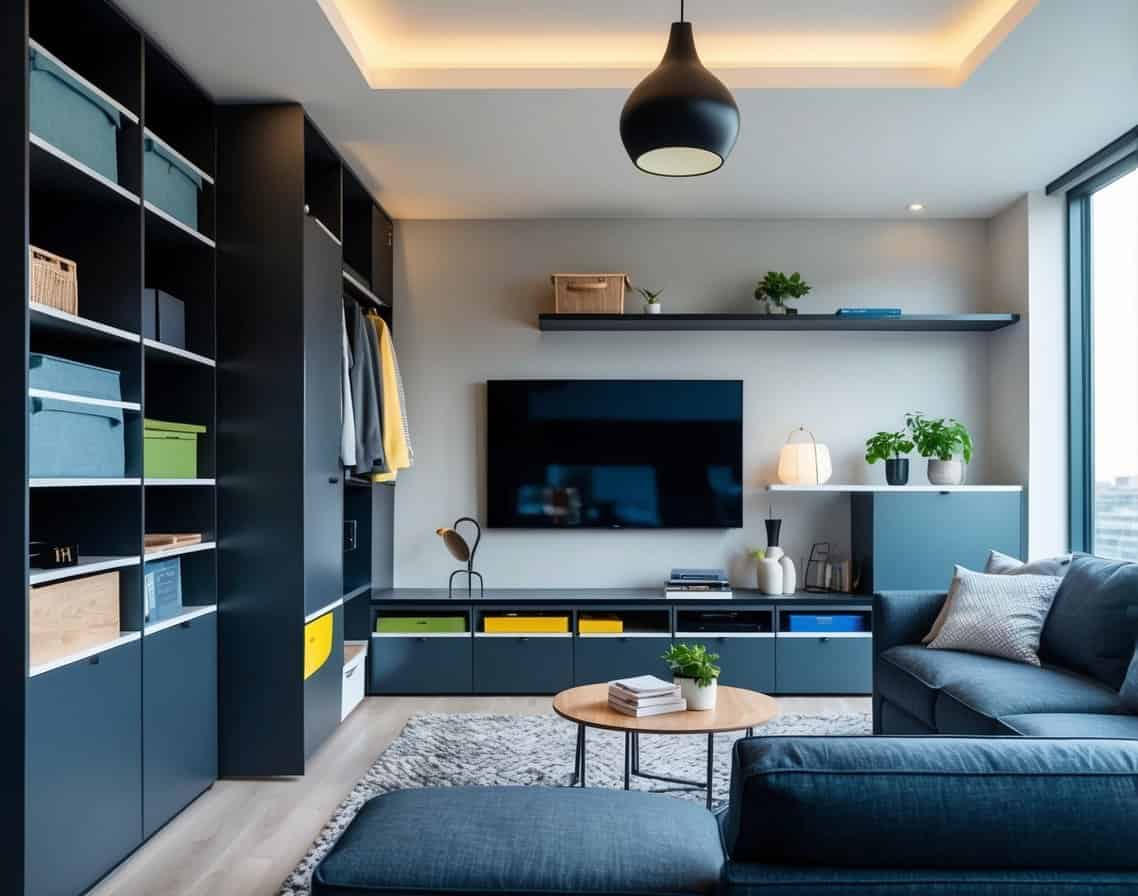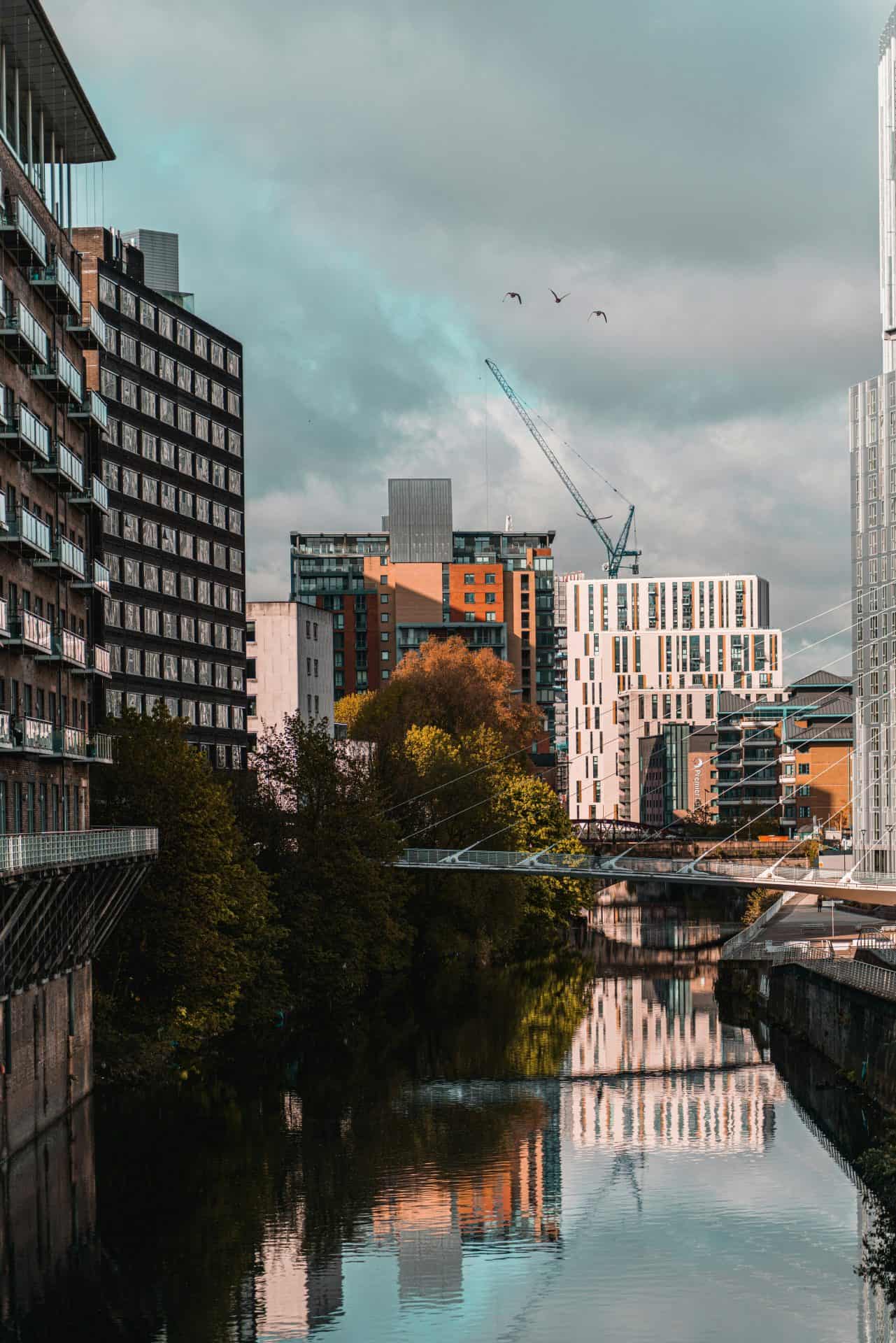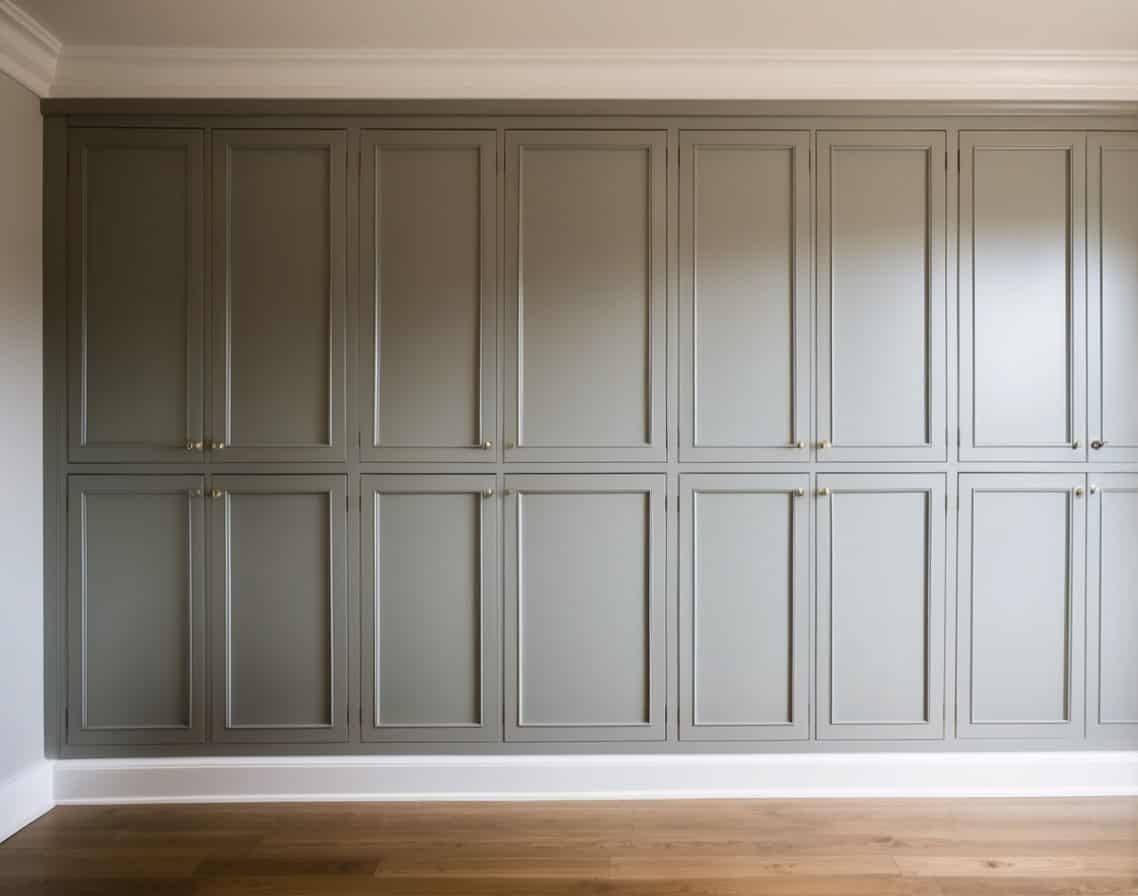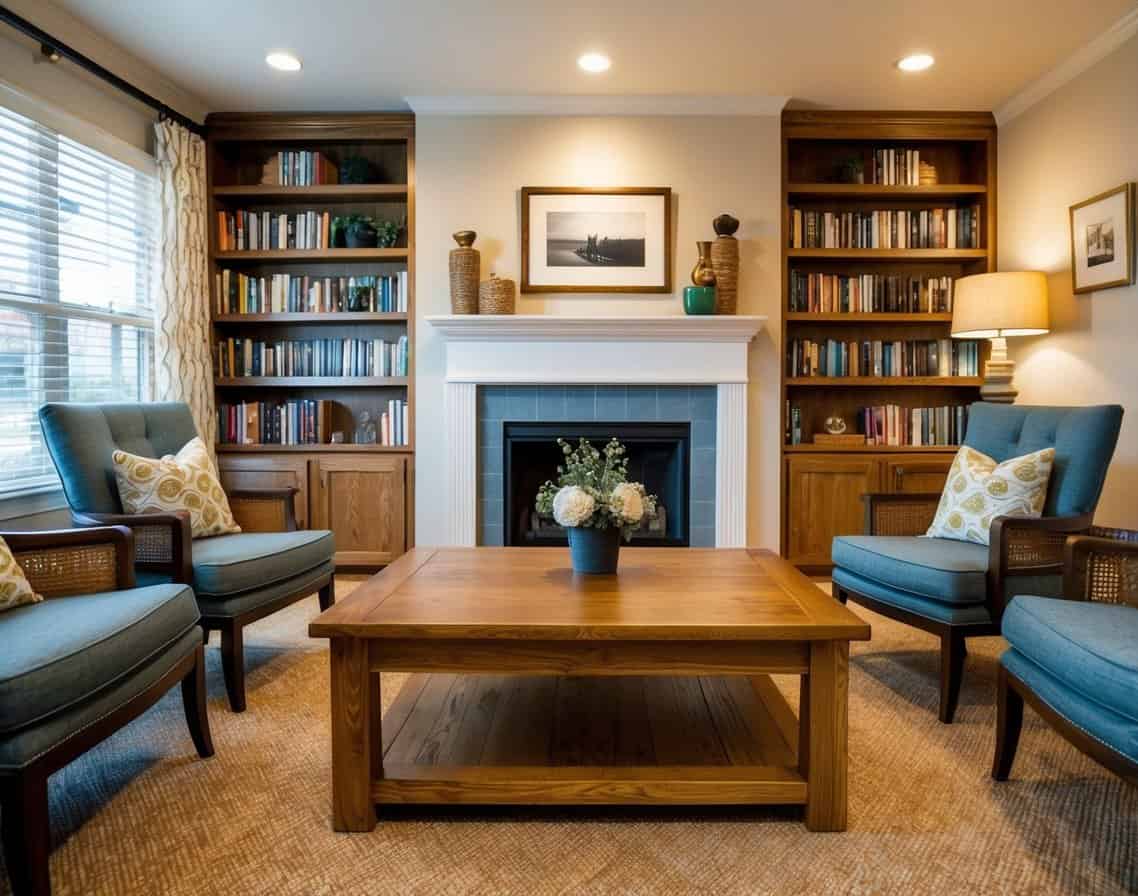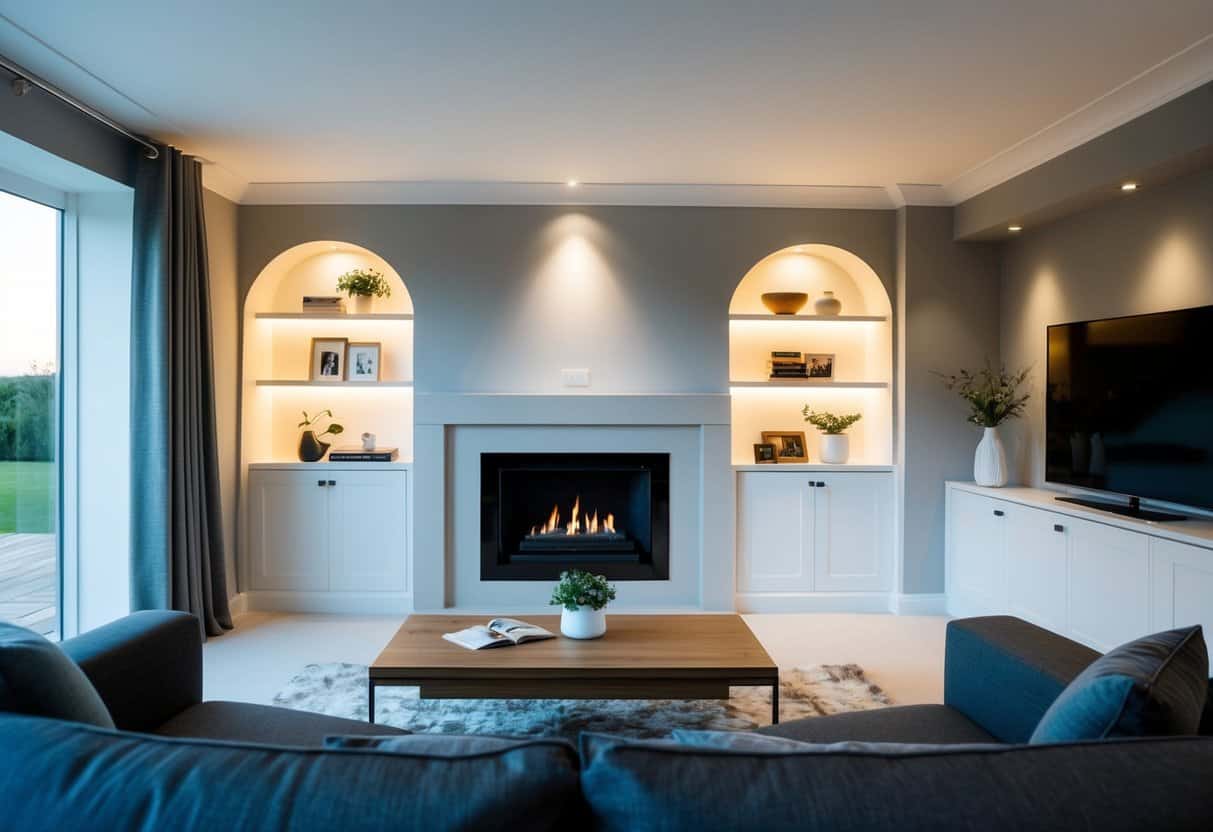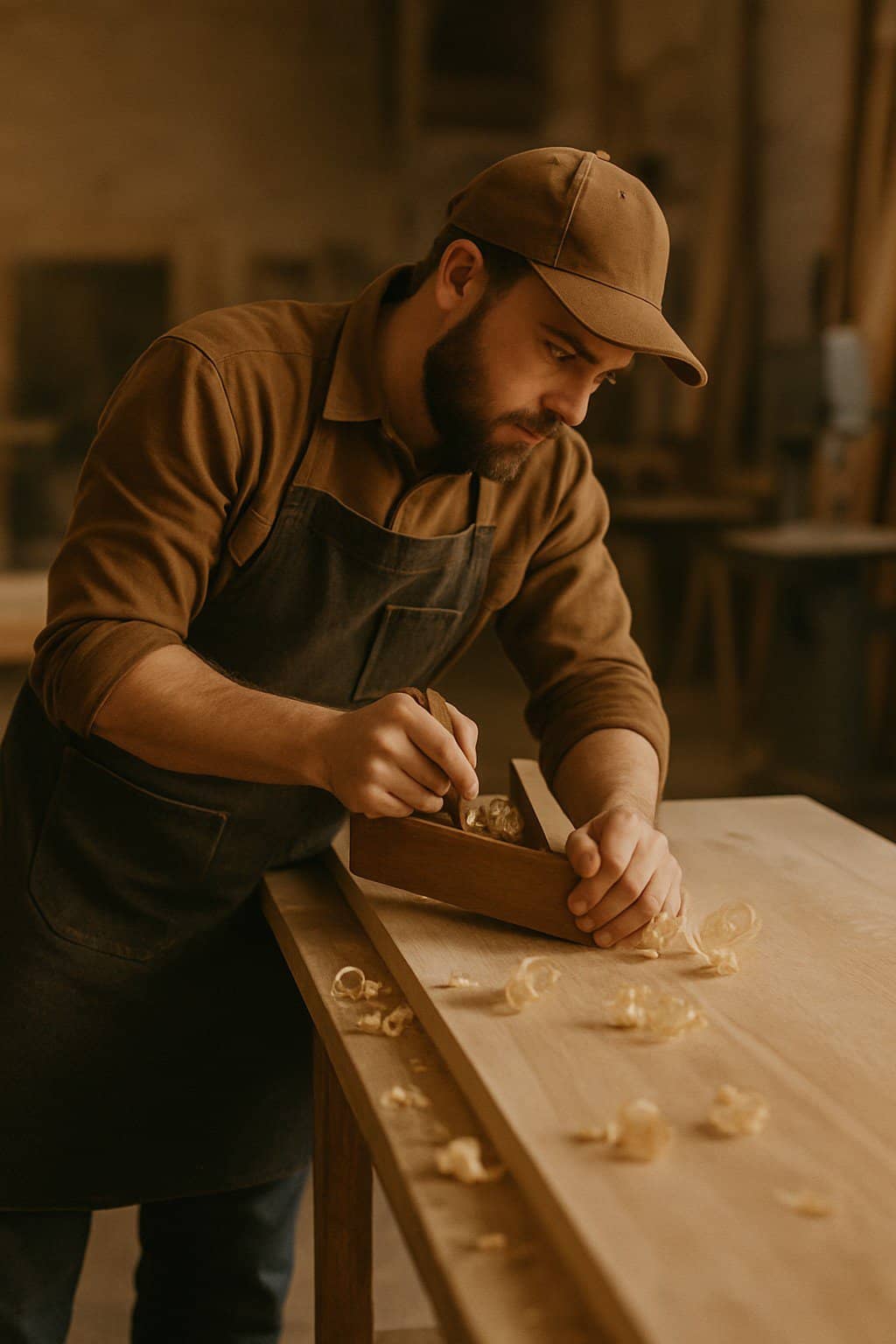Kitchen cabinets are one of the most important design elements in your kitchen. The finish you choose can make or break the entire look of your space. For other spaces, cabinets for living rooms also play a vital role in combining style and function throughout your home.
The right cabinet finish not only enhances your kitchen’s style but also protects against daily wear and ensures your investment lasts for years to come. Colorful possibilities abound when it comes to kitchen cabinet finishing options, allowing you to customize your space to match trending colors or highlight natural wood features.
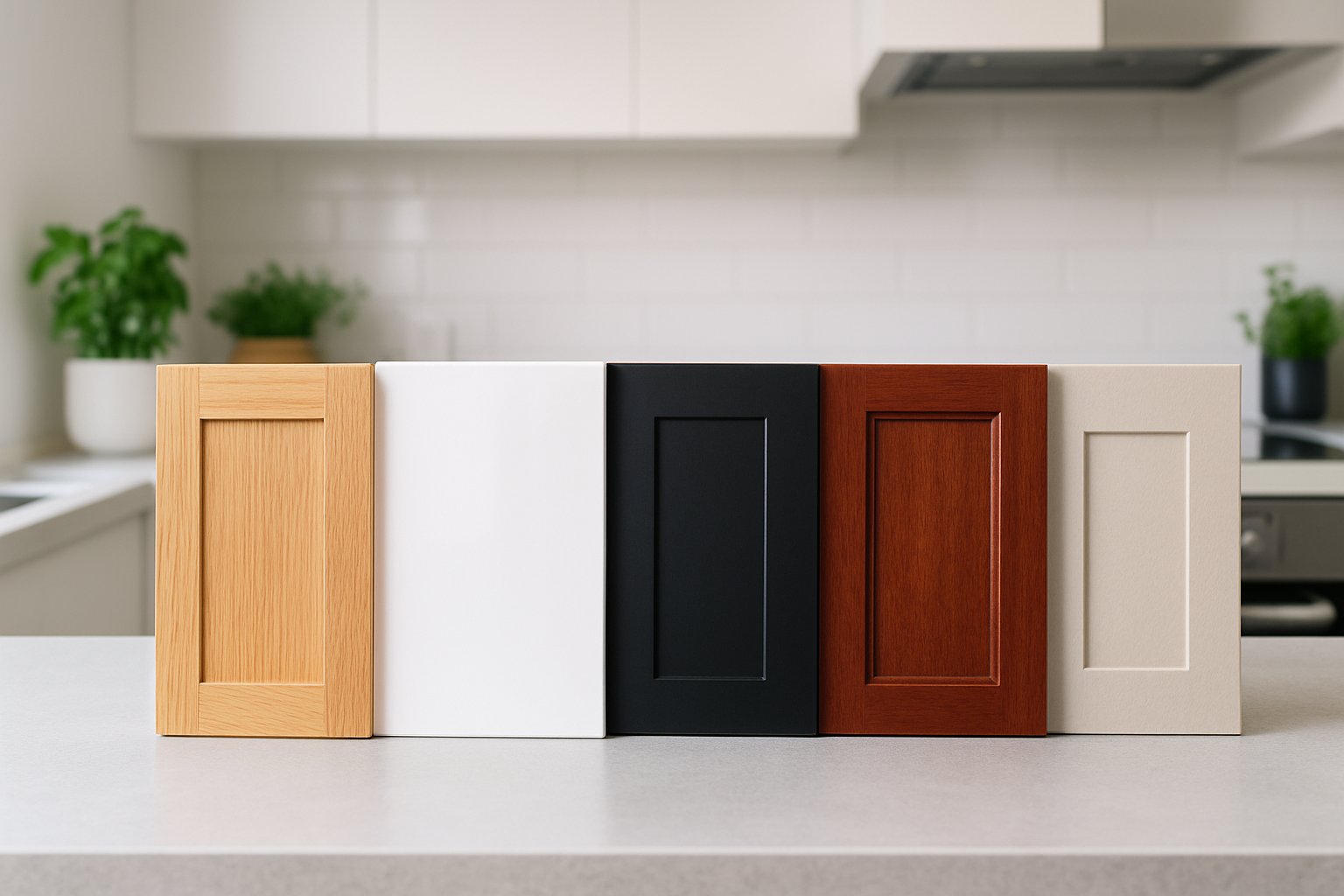
We understand that choosing from the many types of cabinet finishes available today can feel overwhelming. Here’s a quick overview of the different finish options, including stains, paints, glazes, and specialty techniques, to help you get started. From classic painted options to natural wood stains, each of these different finish options offers unique benefits and drawbacks that affect both appearance and durability.
The decision becomes even more complex when you consider factors like your budget, lifestyle, and long-term design goals.
A world of colorful possibilities awaits homeowners exploring kitchen cabinet finishes.
In this guide, we’ll walk you through everything you need to know about kitchen cabinet finishes. We’ll explore popular options like paint and stain, discuss specialty finishes like glazing and distressing, and help you understand which cabinet finish types work best for different situations.
Key Takeaways
- Different cabinet finishes offer unique benefits, from paint’s versatility to stain’s natural beauty
- Your choice should balance style preferences with practical needs like durability and maintenance
- Understanding finish options helps you select the best match for your budget and lifestyle
Understanding Kitchen Cabinet Finishing Options
Kitchen cabinet finishes determine both the appearance and durability of your cabinetry. Options range from natural wood stains to painted surfaces and laminate coatings. These finishes can be applied to a variety of cabinetry products, allowing you to achieve different looks and effects depending on the type of cabinet.
The right finish impacts your kitchen’s aesthetic and longevity. It’s essential to understand each option’s characteristics and benefits. Selecting cabinet finishes is a key step in creating the kitchen style you want.
What Are Kitchen Cabinet Finishes?
Kitchen cabinet finishes are protective and decorative coatings applied to cabinet surfaces. These finishes serve two main purposes: they protect the underlying material from moisture, heat, and daily wear while defining the visual appearance of your cabinetry. Finishes act as a protective layer for the cabinets, shielding them from damage and helping to preserve their durability and appearance.
Cabinet finish can be applied to different base materials. Solid wood cabinets accept stains and paints differently than engineered materials.
Laminate finishes are typically factory-applied, while paint and stain finishes can be applied during manufacturing or as part of a renovation.
The finish you choose affects how your kitchen cabinets look and feel. It determines the colour, texture, and sheen level of your cabinetry.
Some finishes highlight natural wood grain patterns, while others create smooth, uniform surfaces.
Importance of Choosing the Right Finish
Selecting the right finish impacts both style and durability of your kitchen cabinets. The wrong choice can lead to premature wear, damage, and costly repairs.
Different finishes offer varying levels of protection against kitchen hazards:
- Moisture resistance varies significantly between finish types
- Heat tolerance differs based on the coating material
- Scratch resistance depends on finish hardness and composition
- Stain protection varies with surface porosity
Your lifestyle and maintenance preferences should guide your decision. Busy households need durable, easy-to-clean finishes.
Those who prefer natural beauty might choose options that showcase wood grain. Budget considerations also matter.
Some finishes cost more upfront but offer better long-term value through increased durability and lower maintenance needs. Finding the perfect finish means balancing style, durability, and budget to achieve the best result for your kitchen cabinets.
Overview of Finish Types
Common kitchen cabinet finishes include paint, stain, varnish, laminate, and veneer. Each has distinct characteristics and applications.
Paint finishes create solid, uniform colors and can be applied to various base materials. Paint creates an opaque colored finish, especially on tight-grained woods, resulting in a smooth, non-transparent appearance. On coarse-grained woods, such as oak, the grain texture may still be partially visible under the paint. They offer excellent coverage and come in multiple sheen levels from matte to high-gloss.
Stain finishes penetrate wood surfaces to enhance natural grain patterns while adding color. They work best on solid wood cabinetry and require additional protective topcoats.
Laminate finishes are factory-applied synthetic surfaces that resist moisture and stains. They come in numerous colors and patterns, including wood-look options.
Varnish and lacquer finishes provide clear protective coatings that preserve natural wood appearance. They offer excellent durability but require professional application for best results.
Each finish type offers different benefits regarding appearance, durability, and maintenance requirements.
Wood Type and Quality for Cabinets
The type and quality of wood you choose for your cabinets play a crucial role in determining the final look and longevity of your cabinet finish. Each wood species brings its own unique grain texture, color, and natural characteristics, all of which influence how finishes like paint, stain, or semi gloss are absorbed and appear on the surface. For example, coarse grained wood such as oak often requires more finish to achieve a smooth finish, while tighter grained types like maple can deliver a more even, refined appearance—especially when using semi gloss paint or gloss finishes.
Selecting the right wood for your cabinets is about more than just appearance. The grain texture and density of the wood affect not only how the finish looks, but also how durable and easy to maintain your cabinets will be. Oak cabinets, with their prominent grain, can add visual interest and depth, especially when paired with a semi gloss or gloss finish that highlights the wood’s natural beauty. Maple, on the other hand, offers a subtler grain and is ideal for achieving a sleek, smooth finish with paint or stain.
How Wood Species Affect Finish Results
Different wood species interact with cabinet finishes in unique ways. For instance, pine and fir are known for their tendency to absorb stain unevenly, which can result in a blotchy appearance. In contrast, cherry and walnut are prized for their ability to take on a richer color when stained, enhancing the wood’s natural characteristics and creating a luxurious, deep finish. The choice of wood directly impacts the final cabinet finish, so it’s important to consider the desired look you want to achieve.
The natural color and grain of the wood will influence how both paint and stain appear once applied. A durable topcoat is essential for protecting the finish, especially on wood cabinets that see daily use. Whether you’re aiming for a bold, painted finish or a subtle, stained look that lets the wood’s character shine through, understanding the properties of your chosen wood will help you achieve the best results and a finish that lasts.
Selecting Quality Materials for Best Finish
Achieving the best finish for your kitchen cabinets starts with selecting high-quality materials. Premium wood is less likely to have imperfections like knots or uneven grain, which can affect how the finish adheres and looks. Investing in top-tier finish products—such as those with UV protection or enhanced durability—will help maintain the color and integrity of your cabinets over time.
Using the right tools and techniques is just as important as the materials themselves. Proper preparation and application ensure that the finish goes on smoothly and evenly, resulting in a professional appearance. A low-maintenance finish, such as a semi gloss or satin, makes it easy to wipe clean and keep your cabinets looking their best for years to come. By choosing quality wood and finish products, and applying them with care, you’ll enjoy beautiful, long-lasting cabinets that enhance your kitchen’s style.
Painted Kitchen Cabinet Finishes
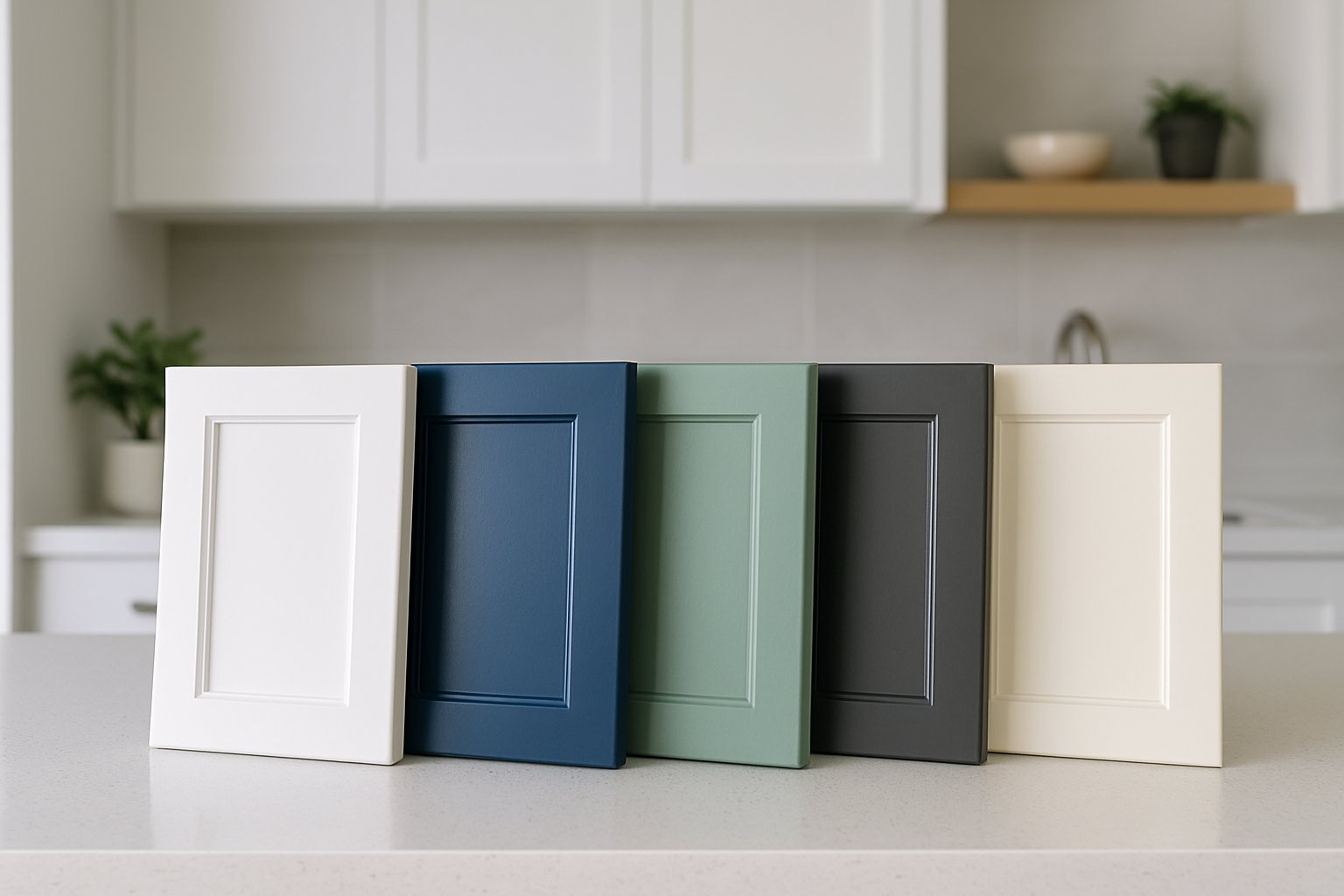
Painted kitchen cabinets offer unlimited color choices and different sheen levels to match any design style. With painted finishes, you can choose from a wide range of cabinet colors to suit your preferences and highlight the unique character of the wood. The type of paint, color selection, and finish sheen each play important roles in both appearance and durability.
Popular Cabinet Paint Types
We recommend using high-quality paints specifically designed for cabinets. These paints resist chipping, scratching, and daily wear better than standard wall paints.
Acrylic latex paints work well for most cabinet projects. They dry quickly, clean up with water, and produce fewer fumes than oil-based options.
Alkyd paints provide a harder, more durable finish. They take longer to dry but create a smooth surface that resists damage from daily use.
Hybrid enamel paints combine the best features of both types. They offer durability like alkyd paints but dry faster and have less odor.
Colour Selection and Trends
White remains the most popular choice for painted kitchen cabinets. It makes kitchens look larger and works with any décor style.
Gray cabinets offer a modern alternative to white. Light greys provide a soft, neutral look while darker greys create drama.
Kitchen cabinet paint colours for 2025 include navy blue, forest green, and warm earth tones. These colours add personality while staying timeless.
Two-tone cabinets combine different colours on upper and lower cabinets. We often see white uppers with darker lower cabinets or a colourful kitchen island.
Matte, Semi-Gloss, and Glossy Paint Finishes
Different paint finishes offer varying levels of shine and durability. Each finish has specific benefits for kitchen use.
Matte finish hides imperfections well but shows fingerprints and grease easily. We don’t recommend matte for high-traffic areas.
Semi-gloss paint provides the best balance for most kitchens. It resists moisture and cleans easily while not showing every fingerprint.
Glossy finish offers maximum durability and easy cleaning. However, it highlights surface imperfections and requires perfect preparation.
Choosing the right paint finish depends on your kitchen’s use and your cleaning preferences. Busy families often prefer semi-gloss for easier maintenance.
Stained Cabinet Finishes
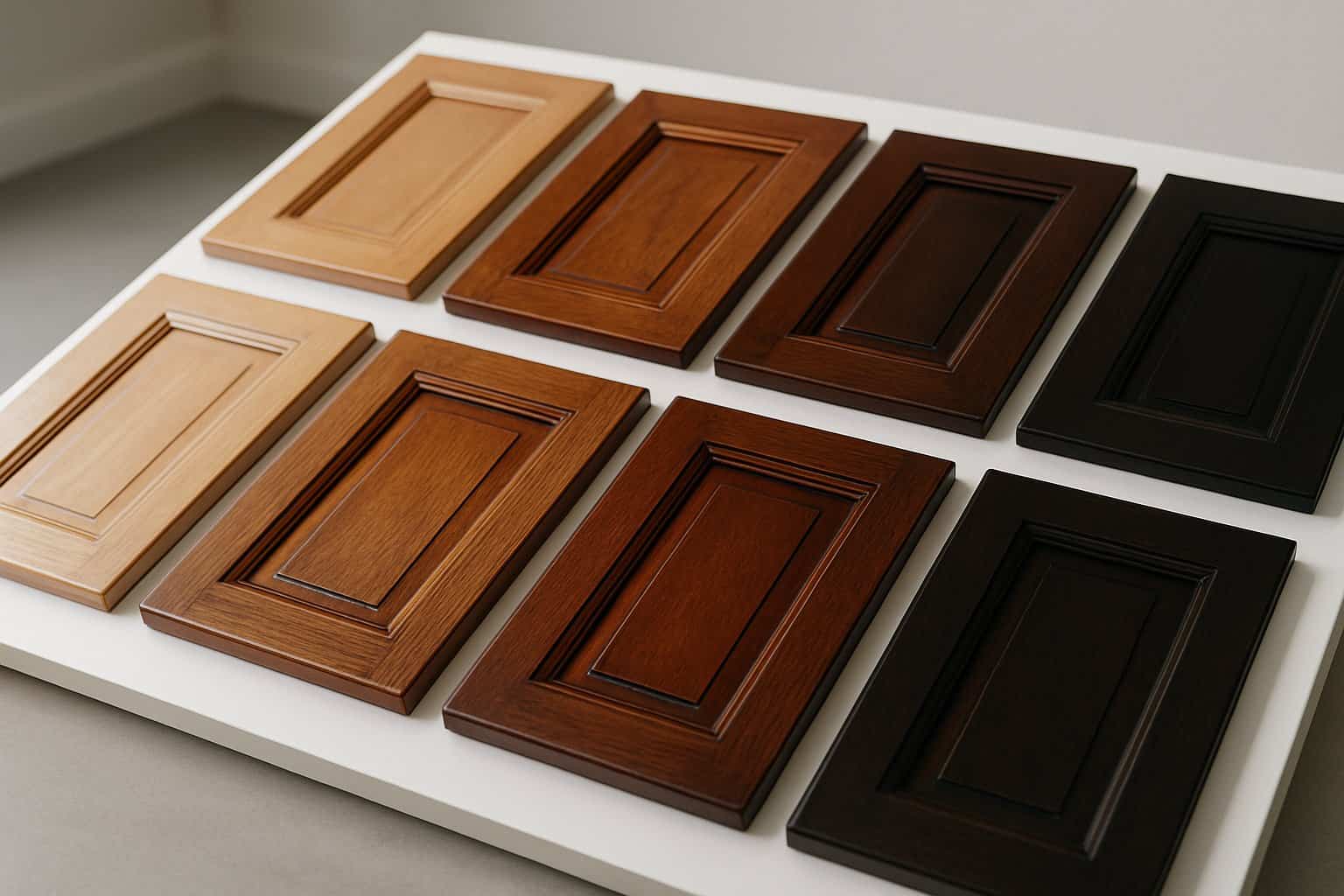
Stained cabinet finishes bring out the natural beauty of wood while offering various colour options and protection levels. Stains are great for adding beautiful color to cabinets, allowing you to achieve anything from a subtle enhancement to a bold transformation. They also enhance the wood’s natural character and provide extra protection, helping to preserve the cabinet’s appearance over time. We can choose from penetrating stains that soak deep into wood fibres, surface stains that add colour on top, or gel stains that provide more control during application.
Types of Cabinet Stains
Penetrating stains work best for natural wood cabinets because they soak into the wood grain. These stains create a natural look that shows the wood’s texture clearly. Making it a versatile cabinet stain.
Gel stains stay on the surface and work well for beginners. They give us more time to work and create even coverage on different wood types.
Water-based stains dry quickly and have less smell than oil-based options. They work well in kitchens where we need to finish projects fast.
Oil-based stains take longer to dry but give deeper colour penetration. These cabinet finishes last longer and resist wear better than water-based types.
Combination stains mix colour and protective finish in one product. We can save time by applying both steps at once.
Enhancing Natural Wood Grain
Cabinet stain works with the wood’s natural patterns instead of hiding them. Light stains show more grain detail while dark stains create bold contrast.
Pre-stain conditioners help soft woods like pine take stain evenly. We apply these products before staining to prevent blotchy results.
Grain direction affects how stain looks on finished cabinets. We always apply stain following the wood grain for the best appearance.
Wood species react differently to the same stain colour. Oak shows bold grain lines while maple creates subtle patterns.
Sanding preparation determines how well stain penetrates the wood. We use 120-grit sandpaper for the final sanding before applying any cabinet stain.
Choosing Stain Shades
Light stains like honey or natural maple make small kitchens look bigger. These shades work as cabinet stains well with modern and traditional styles.
Medium stains such as golden oak or cherry provide warmth without making spaces feel dark. They hide minor scratches better than lighter options.
Dark stains like espresso or ebony create dramatic looks but show dust and fingerprints more easily. We recommend these for larger kitchens with good lighting.
Gray stains offer modern appeal and work with both warm and cool colour schemes. These neutral tones complement stainless steel appliances well.
Custom stain mixing lets us create unique colours that match specific design needs. We can blend different cabinet stain colours to achieve the perfect shade.
Glazed and Distressed Cabinet Finishes
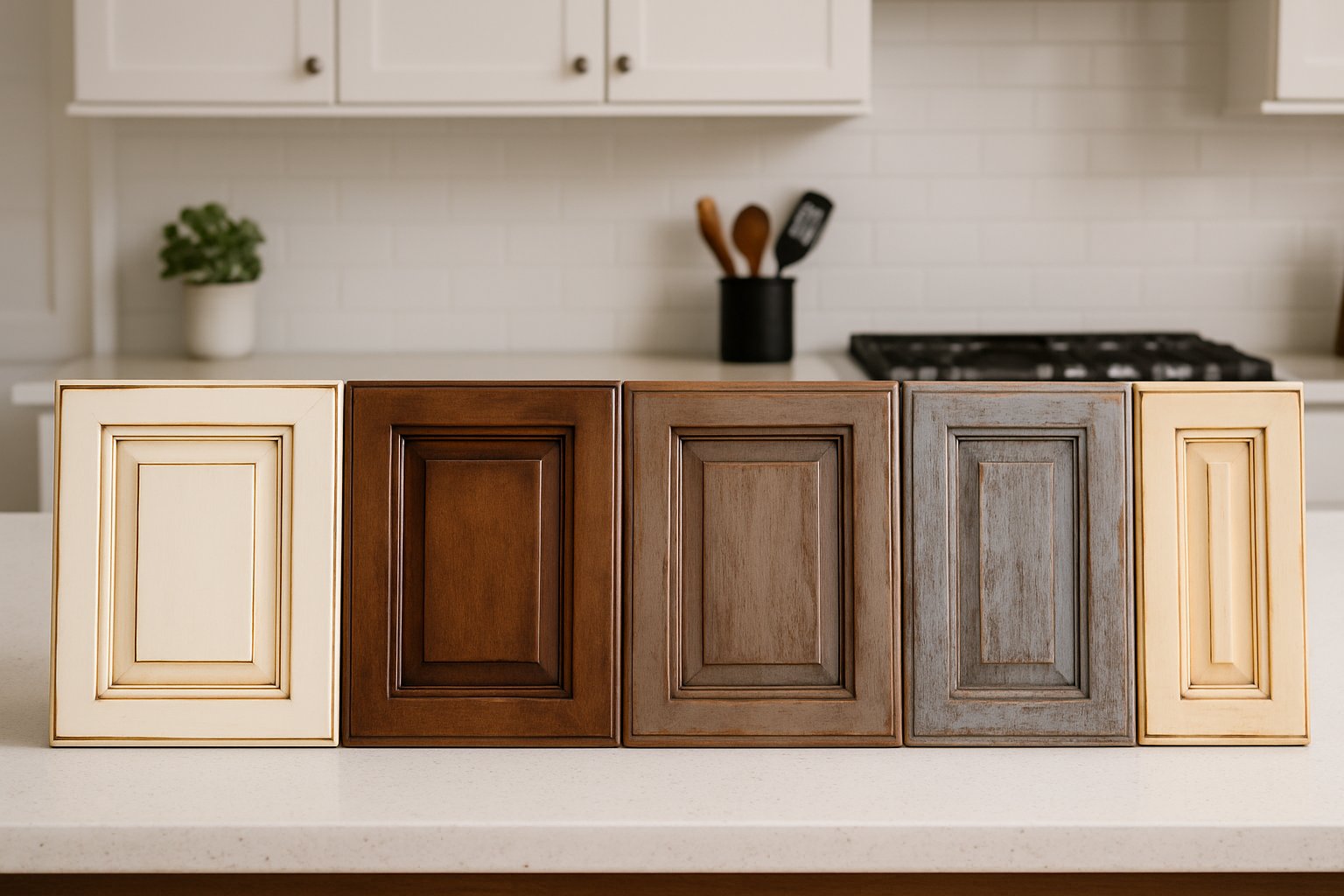
Glazed finishes add depth and dimension to cabinets while creating an antique or aged appearance. Distressing techniques create worn, weathered looks that give new cabinets character and visual interest. These techniques are often used to achieve a shabby chic style, giving cabinetry a vintage, weathered charm.
Cabinet Glazes and Their Application
Cabinet glaze is a translucent coating applied over painted or stained cabinet surfaces. We apply glaze after the base finish has dried completely.
The glaze application process involves several steps. First, we clean the cabinet surface thoroughly.
Then we apply the glaze using a brush, rag, or sponge. We work the glaze into recessed areas and panel details.
The glaze settles into grooves and corners naturally. This creates shadow effects that highlight the cabinet’s architectural features.
Common glaze application methods include:
- Brush application for even coverage
- Rag rolling for textured effects
- Sponge dabbing for subtle patterns
- Dry brushing for light accents
We remove excess glaze before it dries completely. This prevents heavy buildup and maintains the desired look.
The timing depends on the glaze type and room temperature.
Glaze Colors and Effects
Glaze colors range from subtle to dramatic depending on your design goals. We choose colors that complement or contrast with the base cabinet finish.
Popular glaze finish combinations:
Brown and gray glazes create the most natural aging effects. Black glaze produces dramatic contrast on light cabinets.
White glaze softens dark base colors. We can adjust glaze intensity by layering.
Light glazing creates subtle enhancement. Heavy glazing produces more pronounced aging effects.
The glaze finish also affects the final appearance. Matte glazes look more natural.
Satin glazes add slight sheen while maintaining depth.
Distressing Techniques for Cabinets
Distressing creates worn, aged appearances on new cabinets. We use various techniques to simulate years of natural wear and use.
Sand-through distressing removes paint or stain in high-wear areas. We focus on edges, corners, and handles where natural wear occurs.
This reveals the wood underneath or previous finish layers. Dent and ding techniques add physical imperfections.
We use chains, hammers, or other tools carefully. The goal is realistic wear patterns, not random damage.
Dry brushing applies contrasting colors lightly over the base finish. We use minimal paint on the brush.
This creates subtle color variations and highlights raised areas. Crackle finishing creates the appearance of aged, cracked paint.
We apply a special medium between paint layers. As it dries, cracks form naturally in the top coat.
We combine multiple distressing methods for authentic results. The key is restraint and realistic placement of wear marks.
Laminate and Engineered Cabinet Finishes
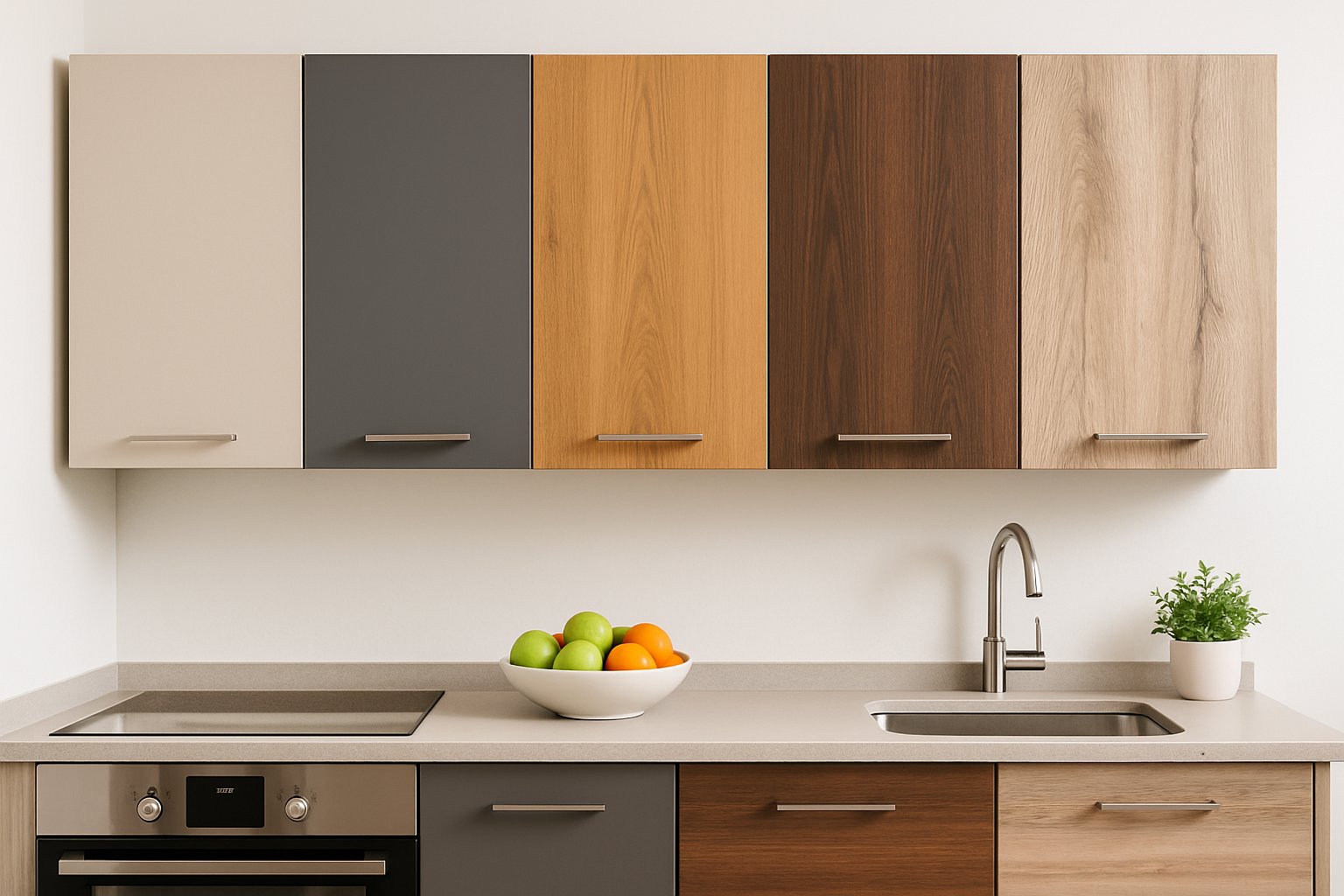
Laminate finished cabinets offer a synthetic alternative that applies thin plastic or paper layers over cabinet surfaces using heat and pressure. These engineered options provide extensive design flexibility while maintaining durability and easy maintenance. Rigid thermofoil is another engineered finish option for cabinets, offering a durable, protective coating that cannot be stained or painted after application and serves as an alternative to wood finishes.
Laminate Finished Cabinets
Laminate cabinets use a manufacturing process that bonds thin synthetic materials to cabinet surfaces. The laminate layer gets applied through heat and pressure techniques.
Modern laminate finishes come in numerous patterns, colors, and textures. Options are available that mimic wood, metal, or marble appearances.
The synthetic nature of laminate makes it resistant to moisture and stains. This quality works well in kitchen environments where spills happen frequently.
Key Benefits:
- Wide range of design options
- Cost-effective compared to natural materials
- Easy to clean and maintain
- Moisture resistant
Melamine and Thermofoil
Melamine uses a paper backing with melamine resin coating. This creates a hard, durable surface that resists scratches and heat damage.
Thermofoil involves applying a vinyl film over medium-density fiberboard (MDF) using heat and vacuum pressure. The process creates smooth, seamless finishes.
Thermofoil versus laminate comparisons show different durability and cost factors. Thermofoil typically costs less but may peel over time near heat sources.
Melamine performs better with heat exposure than thermofoil. This difference is noticeable near stoves and dishwashers where temperatures rise.
Advantages and Limitations
Advantages:
- Budget-friendly pricing compared to solid wood
- Low maintenance requirements
- Consistent appearance without natural wood variations
- Moisture resistance for humid kitchen conditions
Limitations:
- Cannot be refinished like natural wood
- May show wear patterns over time
- Limited repair options if damaged
- Some options may peel near heat sources
Laminate cabinet durability makes them practical for budget-conscious projects. However, the inability to sand and refinish these surfaces should be considered.
The synthetic materials work well for modern and contemporary kitchen designs. Various laminate options suit different aesthetic preferences while maintaining consistent performance standards.
Advanced and Custom Cabinet Finishes
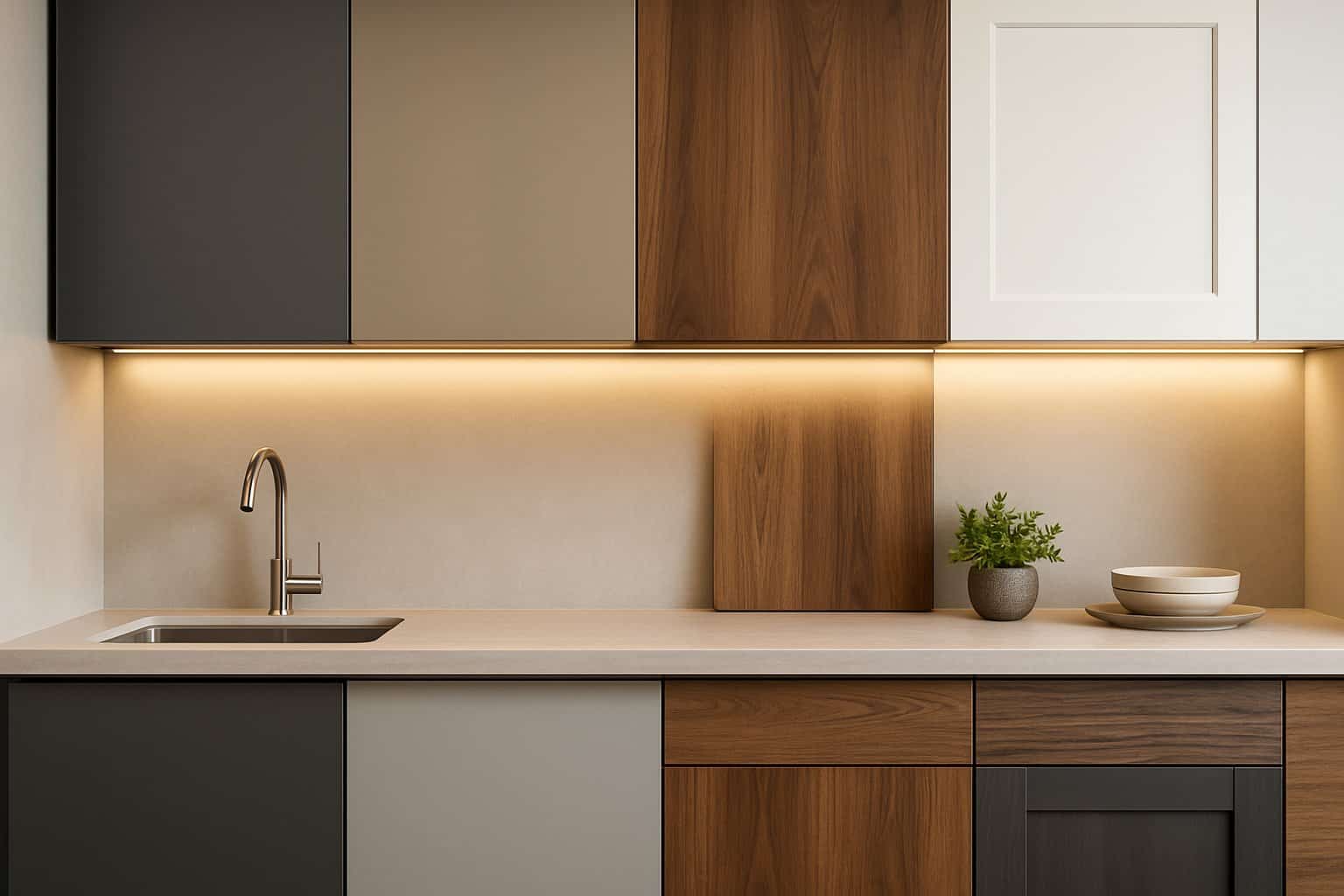
Professional cabinet makers use specialized finishes that go beyond basic paint and stain options. These advanced techniques create unique looks while providing superior protection and durability for your kitchen cabinets. For even more specialized solutions, consider working with local experts who can offer tailored craftsmanship.
Conversion Varnish and Special Topcoats
Conversion varnish stands out as the most durable finish option for kitchen cabinets. This professional-grade coating cures through a chemical reaction rather than simple drying.
Benefits of Conversion Varnish:
- Resists scratches, heat, and moisture damage
- Creates an extremely hard surface
- Maintains clarity over time without yellowing
- Provides consistent sheen across all surfaces
Conversion varnish is recommended for high-traffic kitchens where cabinets face daily wear. The finish requires professional application due to its complex mixing process and chemical components.
Other Special Topcoats:
- Catalyzed lacquer – Fast-drying with excellent durability
- Water-based polyurethane – Low odor with good protection
- UV-cured finishes – Instantly cured with specialized equipment
These topcoats cost more than standard finishes but deliver superior performance. They work best when applied in controlled shop environments rather than on-site installation.
Custom Colors and Textures
Custom cabinet finishes let you match any color or create unique textures that standard options cannot achieve. Paint finishes offer extensive color options, with some collections featuring 17 different color choices.
Color Matching Options:
- Benjamin Moore or Sherwin Williams color matches
- Custom stain colors for wood cabinets
- Metallic and pearl finishes
- Two-tone combinations
Texture Techniques:
- Distressing – Creates aged, vintage appearance
- Glazing – Adds depth and highlights details
- Wire brushing – Raises wood grain for rustic look
- Sand-through – Shows underlying wood or base color
Custom textures require skilled craftsmen who understand how different techniques interact with various wood species. Each method produces distinct visual effects that can transform your kitchen’s overall style.
Finishing Techniques for Unique Looks
Specialized finishing techniques create one-of-a-kind cabinet appearances that cannot be achieved through standard methods. These processes require expertise and additional time from professional cabinet makers but deliver remarkable results.
Multi-Step Processes:
- Base coat application – Establishes primary color
- Accent layer – Adds depth or contrast
- Protective topcoat – Seals and protects finish
Popular Specialty Techniques:
- Antiquing – Creates worn, historic appearance
- Color washing – Applies translucent layers for depth
- Dry brushing – Highlights raised surfaces
- Crackling – Produces aged, cracked paint effect
Multiple techniques can be combined on single projects. For example, a base stain may be applied, glaze accents added, then finished with conversion varnish for maximum protection.
Application Considerations:
- Requires controlled environment for best results
- Takes longer than standard finishes
- Costs more due to additional labor and materials
- May need periodic touch-ups in high-wear areas
These advanced techniques work best when planned during the design phase.
Cabinet Door Styles and Finishes
The style of your cabinet doors is closely linked to the type of finish you choose, as the door profile can dramatically influence the overall appearance of your kitchen cabinets. Whether you prefer a classic raised panel, a sleek recessed panel, or a modern flat-front design, the right finish can highlight or soften the features of your cabinet doors. For example, a semi gloss finish on a raised panel door can create a striking, dimensional effect, while a matte or satin finish on a recessed panel door offers a more understated, contemporary look.
Choosing the right combination of cabinet door style and finish allows you to create a kitchen design that reflects your personal taste and enhances the room’s atmosphere. Gloss finishes can add a touch of luxury and brightness, while more subtle finishes like eggshell or matte paint provide a softer, more relaxed vibe.
Matching Finishes to Door Profiles
When selecting a finish for your cabinet doors, it’s important to consider how the door’s profile will interact with the finish. Doors with intricate details, moldings, or raised panels are perfect candidates for finishes that accentuate these features, such as a high gloss paint or a hand-applied glaze. These finishes catch the light and draw attention to the craftsmanship, adding personality and depth to your kitchen.
On the other hand, simple, flat cabinet doors often look best with a more subtle finish, like matte or satin paint, which creates a clean, modern appearance. If you’re aiming for a unique kitchen design, consider combining different finishes—such as pairing high gloss upper cabinets with semi gloss or matte lower cabinets—to create visual interest and contrast.
Ultimately, the key is to match the right finish to your cabinet doors and overall kitchen style. By thoughtfully selecting both the door profile and the finish, you can create a cohesive, stylish space that feels custom-designed for your home. Whether you want to add personality with a bold gloss or keep things classic with a soft glaze, the possibilities for your kitchen design are nearly endless.
Selecting the Best Finish for Your Kitchen Cabinets
The right cabinet finish depends on your kitchen’s design style, how much daily wear your cabinets will receive, and your long-term renovation goals. Budget constraints and maintenance preferences also play key roles in making the best choice for your home.
Matching Finish to Kitchen Style
Modern kitchens work best with glossy finishes that provide a sleek look. High-gloss paint or lacquer creates clean lines that complement stainless steel appliances and minimalist designs.
Traditional kitchens benefit from natural wood stains or painted finishes with slight texture. Oak, cherry, or maple with medium to dark stains create warmth and classic appeal.
Farmhouse styles pair well with painted finishes in white, cream, or soft gray. Distressed or glazed finishes add character without looking too polished.
Popular Style Combinations:
- Contemporary: High-gloss white or black paint
- Transitional: Semi-gloss painted finish in neutral tones
- Rustic: Natural wood stain with matte protective coating
- Industrial: Dark stained wood or painted metal-look finishes
Popular styles include raised and recessed paneling, which can be paired with various finishes for a trendy and updated look.
Color temperature matters too. Warm wood tones work with brass hardware, while cool painted finishes complement brushed nickel or chrome accents.
Durability and Maintenance Considerations
Kitchen cabinets face daily challenges from grease, moisture, and frequent handling. Choosing finishes that enhance durability protects your investment and reduces long-term costs.
High-Durability Options:
- Polyurethane-based paints: Resist scratches and moisture damage
- Conversion varnish: Professional-grade protection for heavy use
- Catalyzed lacquer: Extremely hard surface that resists chemicals
Semi-gloss and satin finishes clean easier than flat or matte options. Glossy surfaces show fingerprints and water spots more readily but wipe clean with minimal effort.
Natural wood stains require periodic touch-ups and refinishing. Painted surfaces last longer between maintenance cycles but may need spot repairs from chips or scratches.
Maintenance Requirements:
- Daily cleaning: All finishes need regular wiping with appropriate cleaners
- Annual inspection: Check for wear spots or damage
- Touch-up schedule: Painted finishes every 3-5 years, stained every 5-7 years
Impact on Kitchen Remodels
Cabinet finishes significantly affect your kitchen remodel budget and timeline.
Cost Factors:
- Paint finishes: Most affordable option, $2-4 per square foot
- Stain finishes: Mid-range pricing, $3-6 per square foot
- Specialty finishes: Premium options, $5-10 per square foot
Professional application costs more upfront but delivers better results and longevity. DIY projects save money but require proper preparation and technique for lasting results.
Timeline Considerations:
- Painting: 3-5 days including prep and drying time
- Staining: 2-4 days depending on number of coats
- Complex finishes: 5-7 days for glazing or distressing techniques
Market appeal matters for resale value. Neutral painted finishes like white, gray, or navy appeal to most buyers. Bold colors or unusual techniques may limit your buyer pool but can create stunning focal points in forever homes.
Frequently Asked Questions
Kitchen cabinet finishes range from paint and stain to laminate and polyurethane options. Each finish type offers different benefits for durability, maintenance, and appearance in your kitchen space.
What types of finishes are available for kitchen cabinets?
Cabinet finishes fall into several main categories including stain, paint, and laminate options. Stain finishes allow the natural wood grain to show through while adding color.
Paint finishes create a solid color that completely covers the wood surface. These come in matte, satin, and gloss options.
Laminate finishes provide a durable surface that can mimic wood or solid colors. Clear finishes like polyurethane protect the wood while maintaining its natural appearance.
Glazed finishes add depth and character to cabinets. These work well with both painted and stained surfaces.
Which finish offers the greatest durability for kitchen cabinets?
Polyurethane finishes provide excellent durability for kitchen cabinets. They resist moisture, heat, and daily wear better than most other options.
Laminate finishes also offer strong durability. They resist stains, scratches, and moisture damage effectively.
Gloss paint finishes for high-traffic areas clean easily and resist damage. However, they show fingerprints and imperfections more than other paint finishes.
Satin finishes balance durability with appearance. They resist moisture and cleaning while hiding minor imperfections.
How do modern finish options for kitchen cabinets differ from traditional ones?
Modern finishes often use advanced materials and application methods. More water-based products dry faster and have less odor than traditional oil-based finishes.
Traditional finishes relied heavily on oil-based stains and varnishes. These took longer to dry and had stronger chemical odors.
Modern laminate finishes can now mimic wood grain and texture very closely. Traditional laminates were obviously artificial in appearance.
Modern paint finishes offer better durability and color retention. They also come in more color options than traditional cabinet paints.
What are the benefits of using a polyurethane finish on kitchen cabinets?
Polyurethane creates a hard, protective surface that resists water damage. This makes it ideal for kitchen environments where moisture is common.
Polyurethane finishes resist heat damage from cooking activities. They also protect against scratches and dents from daily use.
These finishes are easy to clean with mild soap and water. They don’t require special cleaning products or treatments.
Polyurethane maintains the natural wood appearance while providing protection. It comes in clear, satin, and gloss options to match your preferences.
Why might someone choose laminate finishes for their kitchen cabinetry?
Laminate finishes cost less than solid wood or painted options. This makes them popular for budget-conscious kitchen projects.
Laminate finishes offer excellent durability against moisture and stains. They work well in busy kitchens with heavy use.
These finishes require minimal maintenance compared to wood finishes. They don’t need regular refinishing or special care products.
Laminate comes in many colors and patterns including wood grain looks. This gives you design flexibility at a lower cost.
What are the best practices for applying a clear finish to wood kitchen cabinets?
We recommend starting with properly sanded wood surfaces. Sand progressively from coarse to fine grits.
Clean all dust and debris from the wood before applying finish. Use a tack cloth or compressed air to remove particles.
Apply thin, even coats rather than thick applications. This prevents drips and ensures proper drying.
Lightly sand between coats with fine sandpaper. This helps the next coat adhere properly and creates a smooth surface.
Allow each coat to dry completely before applying the next one. Follow the manufacturer’s recommended drying times.

